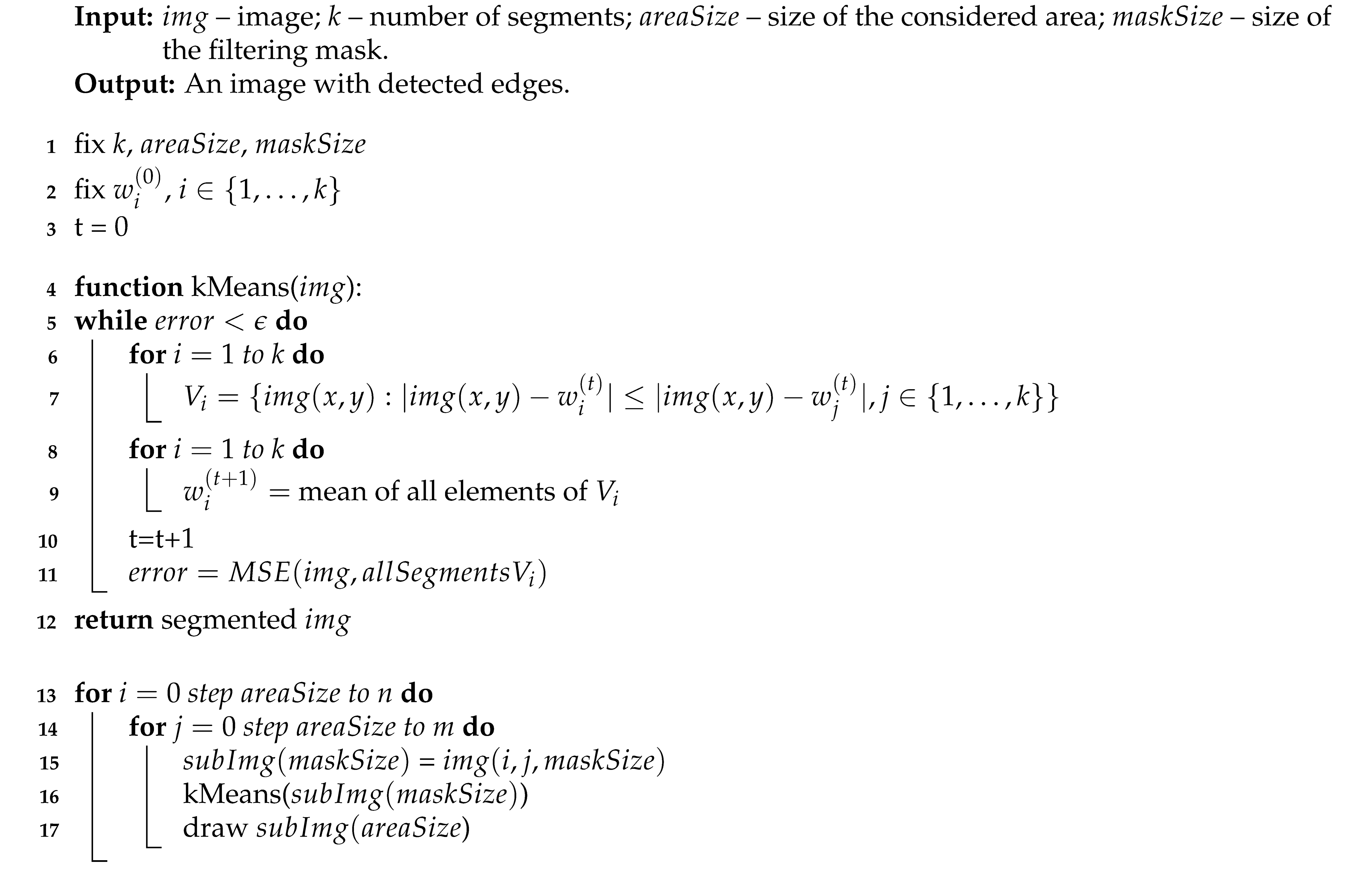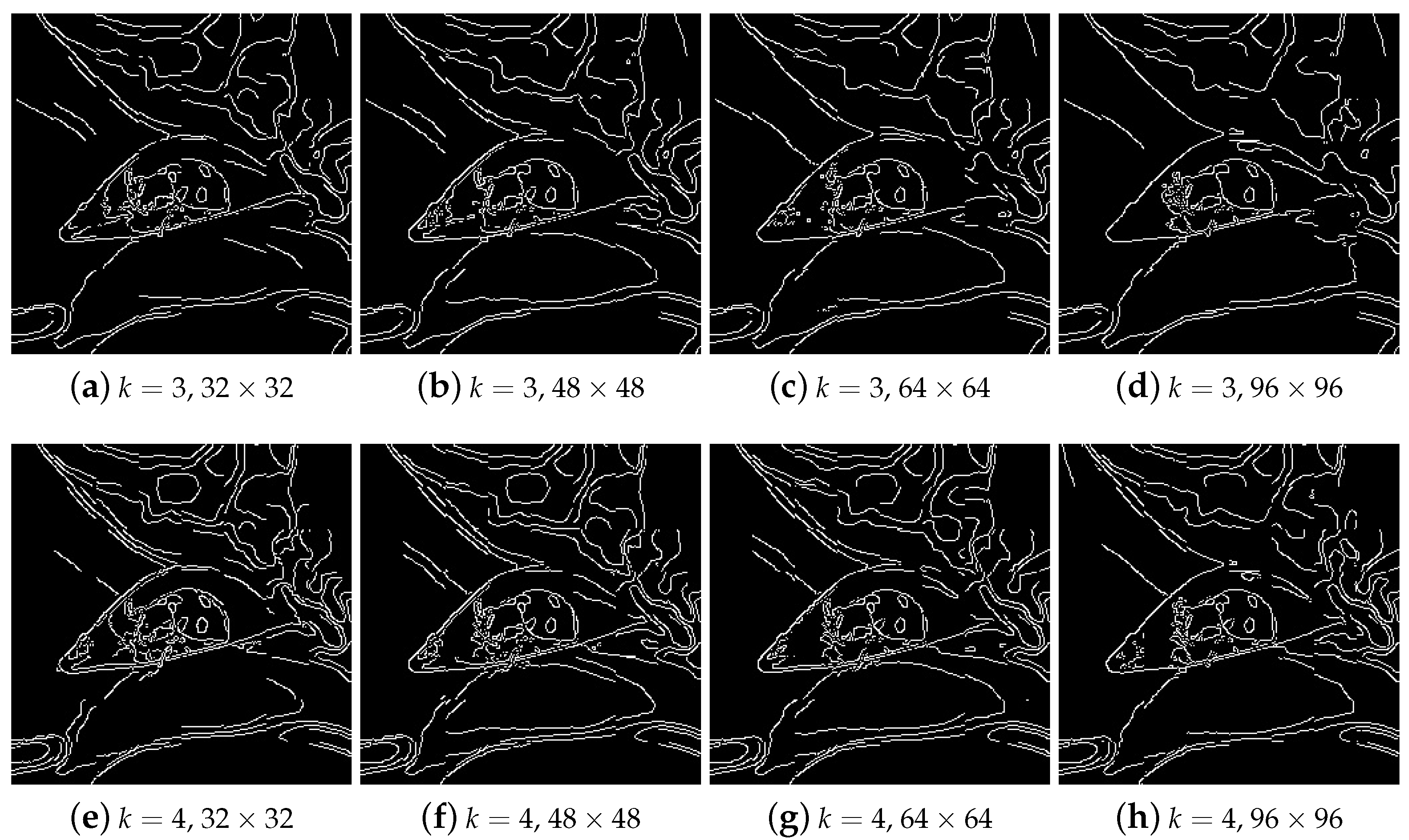Efficient Edge Detection Method for Focused Images
Abstract
1. Introduction
2. Related Work
3. Edge Detection
3.1. Limitations of the Existing Models
3.2. k-Means Algorithm
4. Edge Detection by the Local k-Means
| Algorithm 1: The local k-Means edge detection. |
 |
5. Experimental Results
6. Summary
Funding
Conflicts of Interest
References
- Tovee, M.J. An Introduction to the Visual System; Cambridge University Press: Cambridge, UK, 2008. [Google Scholar]
- Sun, R.; Lei, T.; Chen, Q.; Wang, Z.; Du, X.; Zhao, W.; Nandi, A.K. Survey of Image Edge Detection. Front. Signal Process. 2022, 2. [Google Scholar] [CrossRef]
- Ziou, D.; Tabbone, S. Edge Detection Techniques-An Overview. Pattern Recognit. Image Ann. 1998, 8, 537–559. [Google Scholar]
- Prewitt, J.M. Object enhancement and extraction. Pict. Process. Psychopictor. 1970, 10, 15–19. [Google Scholar]
- Shrivakshan, G.T.; Chandrasekar, C. A Comparison of Various Edge Detection Techniques Used in Image Processing. Int. J. Comput. Sci. Issues 2012, 9, 269. [Google Scholar]
- Sobel, I.; Feldman, G. A 3 × 3 isotropic gradient operator for image processing. In A Talk at the Stanford Artificial Project; Stanford University: Stanford, CA, USA, 1968; pp. 271–272. [Google Scholar]
- Sobel, I. Camera Models and Machine Perception. Ph.D. Thesis, Electrical Engineering Department, Stanford University, Stanford, CA, USA, 1970. [Google Scholar]
- Canny, J. A Computational Approach to Edge Detection. IEEE Trans. Pattern Anal. Mach. Intell. 1986, 8, 679–698. [Google Scholar] [CrossRef] [PubMed]
- Marr, D.; Hildreth, E. Theory of Edge Detection. Proc. R. Soc. Lond. 1980, 207, 187–217. [Google Scholar] [PubMed]
- Wang, X. Laplacian Operator-Based Edge Detectors. IEEE Trans. Pattern Anal. Mach. Intell. 2007, 29, 886–890. [Google Scholar] [CrossRef]
- Kang, H.; Lee, S.; Chui, C.K. Coherent Line Drawing. In Proceedings of the 5th International Symposium on Non-Photorealistic Animation and Rendering, San Diego, CA, USA, 4–5 August 2007; pp. 43–50. [Google Scholar]
- Arbelaez, P.; Maire, M.; Fowlkes, C.; Malik, J. Contour Detection and Hierarchical Image Segmentation. IEEE Trans. Pattern Anal. Mach. Intell. 2010, 33, 898–916. [Google Scholar] [CrossRef]
- Al Darwich, R.; Babout, L.; Strzecha, K. An Edge Detection Method Based on Local Gradient Estimatio. Application to High-Temperature Metallic Droplet Images. Appl. Sci. 2022, 12, 6976. [Google Scholar] [CrossRef]
- Hough, P.V.C. Method and Means for Recognizing Complex Patterns. U.S. Patent 3069654, 18 December 1962. [Google Scholar]
- Popovici, I.; Withers, W.D. Custom-build moments for edge location. IEEE Tans. Pattern Anal. Mach. Intell. 2006, 28, 637–642. [Google Scholar] [CrossRef]
- Lisowska, A. Multiscale moments-based edge detection I. In Proceedings of the EUROCON ’09 Conference, St. Petersburg, Russia, 18–23 May 2009; pp. 1414–1419. [Google Scholar]
- Yi, S.; Labate, D.; Easley, G.R.; Krim, H. A Shearlet Approach to Edge Analysis and Detection. IEEE Trans. Image Process. 2009, 8, 929–941. [Google Scholar]
- Lisowska, A. Edge Detection by Sliding Wedgelets. In Lecture Notes in Computer Science; Part 1; Springer: Berlin/Heidelberg, Germany, 2011; Volume 6753, pp. 50–57. [Google Scholar]
- Lisowska, A. Geometrical Multiresolution Adaptive Transforms. Theory and Applications; Springer: Berlin/Heidelberg, Germany, 2014. [Google Scholar]
- Criminisi, A.; Shotton, J.; Konukoglu, E. Decision Forest. A Unified Framework for Classification, Regression, Density Estimation, Manifold Learning and Semi-supervised Learning. Found. Trends Comput. Graph. Vis. 2012, 7, 81–227. [Google Scholar] [CrossRef]
- Dollar, P.; Zitnick, C.L. Structured Forests for Fast Edge Detection. In Proceedings of the IEEE International Conference on Computer Vision, Sydney, Australia, 1–8 December 2013; Volume 1, pp. 1841–1848. [Google Scholar]
- Hallman, S.; Fowlke, C.C. Oriented edge forests for boundary detection. In Proceedings of the the IEEE Conference on Computer Vision and Pattern Recognition, CVPR, Boston, MA, USA, 7–12 June 2015; pp. 1732–1740. [Google Scholar]
- Walaa, K.; Kadhum, A.M.; Noor, H. A Novel Edge Detection Method Using K-Means Clustering. J. Eng. Sustain. Dev. 2016, 20, 207–215. [Google Scholar]
- Kapil, S.; Chawla, M.; Ansari, M.D. On K-means data clustering algorithm with genetic algorithm. In Proceedings of the 2016 Fourth International Conference on Parallel, Distributed and Grid Computing (PDGC), Solan, India, 22–24 December 2016; pp. 202–206. [Google Scholar]
- Zheng, X.; Lei, Q.; Yao, R.; Gong, Y.; Yin, Q. Image Segmentation Based on Adaptive k-Means Algorithm. EURASIP J. Image Video Process. 2018, 2018, 68. [Google Scholar] [CrossRef]
- Lim, J.J.; Zitnick, C.L.; Dollar, P.; Sketch, T. A Learned Mid-level Representation for Contour and Object Detection. In Proceedings of the IEEE Conference on Computer Vision and Pattern Recognition, Portland, OR, USA, 23–28 June 2013; pp. 3158–3165. [Google Scholar]
- Mathur, N.; Dadheech, P.; Gupta, M.K. The K-means Clustering Based Fuzzy Edge Detection Technique on MRI Images. In Proceedings of the International Conference on Advances in Computing and Communications (ICACC), Kochi, India, 2–4 September 2015. [Google Scholar]
- Bertasius, G.; Shi, J.; Torresani, L. Deepedg: A Multi-Scale Bifurcated Deep Network for Top-Down Contour Detection. In Proceedings of the IEEE Conference on Computer Vision and Pattern Recognition, Boston, MA, USA, 7–12 June 2015; pp. 4380–4389. [Google Scholar]
- Xie, S.; Tu, Z. Holistically-Nested Edge Detection. In Proceedings of the ICCV, Santiago, Chile, 7–13 December 2015; pp. 1395–1403. [Google Scholar]
- Ganin, Y.; Lempitsky, V. N4-Field. Neural Network Nearest Neighbor Fields for Image Transforms. In Proceedings of the Asian Conference on Computer Vision, Singapore, 1–5 November 2014. [Google Scholar]
- Hwang, J.J.; Liu, T.L. Pixel-Wise Deep Learning for Contour Detection. In Proceedings of the 3rd International Conference on Learning Representations, ICLR, San Diego, CA, USA, 7–9 May 2015. [Google Scholar]
- Yang, J.; Price, B.L.; Cohen, S.; Lee, H.; Yang, M.H. Object contour detection with a fully convolutional encoder-decoder network. In Proceedings of the 2016 IEEE Conference on Computer Vision and Pattern Recognition, CVPR, Las Vegas, NV, USA, 27–30 June 2016; pp. 193–202. [Google Scholar]
- He, J.; Zhang, S.; Yang, M.; Shan, Y.; Huang, T. Bi-directional cascade network for perceptual edge detection. In Proceedings of the 2019 IEEE/CVF Conference on Computer Vision and Pattern Recognition, CVPR, Long Beach, CA, USA, 15–20 June 2019; pp. 3828–3837. [Google Scholar]
- Andrade-Loarca, H.; Kutyniok, G.; Oktem, O. Shearlets as feature extractor for semantic edge detectio. The model-based and data-driven realm. Proc. R. Soc. 2020, 476, 20190841. [Google Scholar] [CrossRef] [PubMed]
- Su, Z.; Liu, W.; Yu, Z. Pixel Difference Networks for Efficient Edge Detection. In Proceedings of the Computer Vision and Pattern Recognition, Nashville, TN, USA, 20–25 June 2021. [Google Scholar]
- Theodoridis, S.; Koutroumbas, K. Pattern Recognition; Academic Press: Cambridge, MA, USA, 2008. [Google Scholar]
- Leydier, Y.; Bourgeois, F.; Emptoz, H. Serialized k-Means for Adaptative Color Image Segmentation. Application to Document Images and Others, I. Document Analysis Systems VI DAS 2004. In Lecture Notes in Computer Science; Marinai, S., Dengel, A.R., Eds.; Springer: Berlin/Heidelberg, Germany, 2004; Volume 3163. [Google Scholar]
- The Database of Free Images. Available online: https://www.freeimages.com/ (accessed on 13 January 2022).
- Schelling, B.; Plant, C. KMN—Removing Noise from K-Means Clustering Results. In Big Data Analytics and Knowledge Discovery; Springer: Berlin/Heidelberg, Germany, 2018. [Google Scholar]










| PSNR | Global k-Means | Local k-Means |
|---|---|---|
| Ladybird | 30.26 | 31.68 |
| Monarch | 29.38 | 30.16 |
| Parrots | 29.13 | 30.81 |
| Bee | 29.13 | 30.2 |
| Soup | 28.84 | 30.12 |
| Balls | 31.40 | 35.51 |
Publisher’s Note: MDPI stays neutral with regard to jurisdictional claims in published maps and institutional affiliations. |
© 2022 by the author. Licensee MDPI, Basel, Switzerland. This article is an open access article distributed under the terms and conditions of the Creative Commons Attribution (CC BY) license (https://creativecommons.org/licenses/by/4.0/).
Share and Cite
Lisowska, A. Efficient Edge Detection Method for Focused Images. Appl. Sci. 2022, 12, 11668. https://doi.org/10.3390/app122211668
Lisowska A. Efficient Edge Detection Method for Focused Images. Applied Sciences. 2022; 12(22):11668. https://doi.org/10.3390/app122211668
Chicago/Turabian StyleLisowska, Agnieszka. 2022. "Efficient Edge Detection Method for Focused Images" Applied Sciences 12, no. 22: 11668. https://doi.org/10.3390/app122211668
APA StyleLisowska, A. (2022). Efficient Edge Detection Method for Focused Images. Applied Sciences, 12(22), 11668. https://doi.org/10.3390/app122211668






